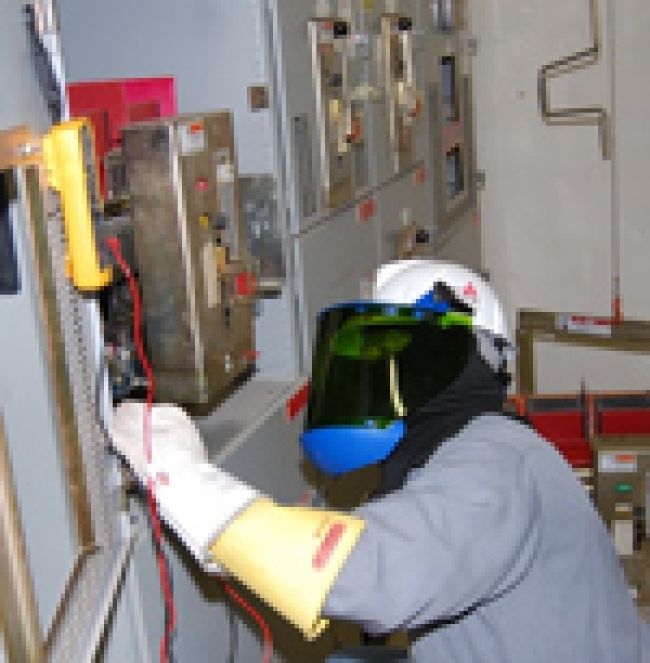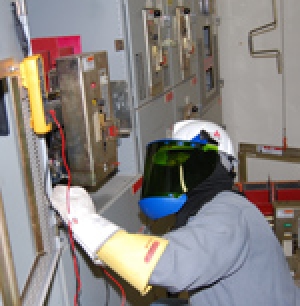
Arc Flash Exposure Revisited: NESC 2012 Part 4 Update

The 2012 edition of the National Electrical Safety Code (NESC) hit the streets August 1. The updated code adds a new dimension to electric utility arc flash implementation with the inclusion of voltages from 50-1000V. Previous editions have required employers to assess voltages over 1000V for potential electric arc flash exposure and to provide clothing or a clothing system with an effective arc rating for the anticipated arc energy.
Major Changes
NESC 2012 requires employers to assess low voltages, 50-1000V, for electric arc flash exposure. Many utilities are currently using NESC 2007’s exception for secondary systems below 1000V, which allows clothing/clothing systems with a minimum effective arc rating of 4 cal/cm2. Utilities using this exception may find the new code somewhat difficult to incorporate into their current arc flash implementation plans.
Arc flash changes include the addition of table 410-1 (50V-1000V) with extensive footnotes and updates to tables 410-2 (1.1 kV to 46 kV) and 410-3 (46.1 kV to 800 kV). Other code changes include the addition of job briefing requirements and changes in tables 441-1 (AC live work minimum approach distance) and 441-2 (DC live work minimum approach distance).
Determining Effective Arc Rating
The updated code requires employers to determine the effective arc rating of clothing or clothing systems for low-voltage lines, parts and equipment. Effective arc ratings can be determined by completing a detailed arc hazard analysis or by using the tabulated values found in table 410-1. Table 410-1 outlines equipment types, nominal voltage ranges and arc thermal performance values (ATPV) cal/cm2 for clothing or clothing systems for employees working on or near energized lines, parts or equipment.
Table 410-1
Table 410-1 is divided into three nominal voltage ranges – 50-250V, 251-500V and 501-1000V – and five equipment types. The new table uses an 18-inch worker separation unlike the existing high-voltage tables, which use a 15-inch worker separation. Changes were based on IEEE 1584 test methodology and typical working distances for low-voltage motor control centers and panel boards.
The table identifies work performed on or near metal-clad switchgear and motor control centers as requiring the highest effective arc rating of clothing or clothing systems ranging from 8 cal/cm2 to 60 cal/cm2 depending on the voltage. Self-contained meters/cabinets range from 4 cal/cm2 to 30 cal/cm2. Pedestals, pull boxes and hand holes range from 4 to 12 cal/cm2.
CT meters, control wiring, open air equipment and pad-mounted transformers range from 4 cal/cm2 to 6 cal/cm2.
Arc Flash Risk Factors
Previous codes gave no methodology for development of arc flash implementation so most utilities use other consensus codes, such as NFPA 70E and IEEE 1584, to determine best practice implementation strategies. Clause 9, which was highlighted in the 2012 change proposals, did provide some possible risk factors that could be considered when developing an arc flash implementation plan.
Possible risk factors include equipment condition, work methods, task elements, incident energy specifics and flash hazard analysis details. Equipment condition includes equipment failure records and whether the equipment is showing visible signs of distress.
Work methods include whether the task requires exposing an energized part, opening a door or removing an access panel; the ease of movement near the energized part and the working position required; and whether the work is in an open area or a confined space. Others include how the work will be accessed – such as by ladder, steel structure, aerial lift, climbing or helicopter; the level of employee training necessary to perform work; and whether the methods used will be for de-energized or energized work using rubber gloves, live-line tools or the live-line bare-hand method.
Other risk factors include the status of lockout/tagout devices, and if the task requires a circuit transitional change such as opening a breaker, opening a disconnect switch, lifting a jumper or replacing a fuse. Does the crew have enough employees to complete the work safely and are they qualified to perform the work? Additional risk factors to be considered are weather and lighting conditions and the cleanliness of the work area.
Incident energy specifics include the level of possible incident energy, distance from a possible arcing source, voltage involved, arcing fault current and the flash hazard analysis.
Job Briefing
Specific job briefing requirements were added to the duties of a first-level supervisor or person in charge. NESC 2007 does not contain a specific requirement to conduct a job briefing, so this change will better align the code with current OSHA job briefing requirements. Job briefing topics include work procedures, personal protective equipment requirements, energy source controls, hazards associated with the job and special precautions.
Minimum Approach Distance
The methodology for calculating minimum approach distances was taken from IEEE 516-2009, “IEEE Guide for Maintenance Methods on Energized Power Lines.” Updates include the deletion of tables 441-2 through 441-3 (AC live work minimum approach distances for altitudes less than 3000 feet above sea level, where T has been determined according to Rule 441A5); the addition of a new table 441-2 (DC live work minimum approach distances); and updates to table 441-1 (AC live work minimum approach distance) to include voltages up to 800 kV. Transmission voltages (72.6-800 kV) include minimum approach distances without tools phase-to-ground, with tools phase-to-ground and without tools phase-to-phase.
For more information on these and other changes, refer to NESC 2012.
About the Author: Pam Tompkins, CSP, CUSA, CUSP, is president of SET Solutions in Lexington, S.C. She is a founding member of the USOLN and presently a CUSP board member. Prior to forming her own company in 2000, Pam worked in the electric utility industry for more than 20 years. She specializes in helping small- to medium-size electric utilities comply with today’s safety management and training requirements.

